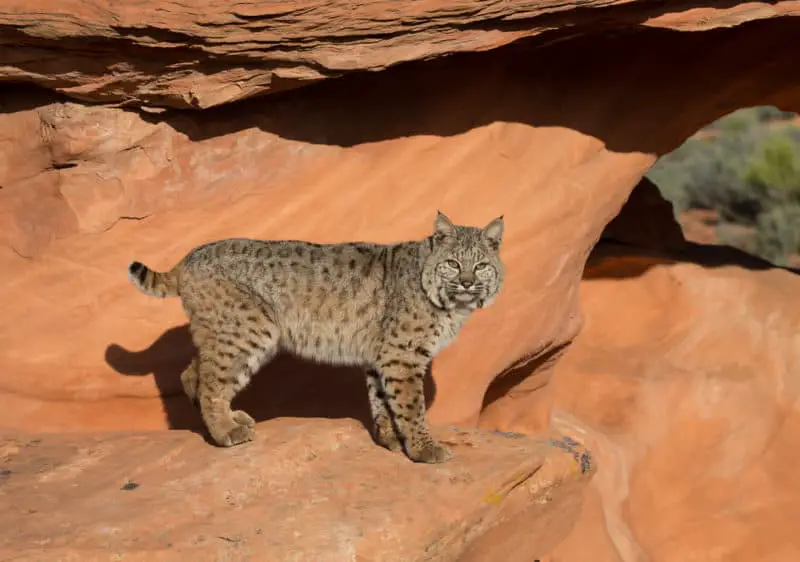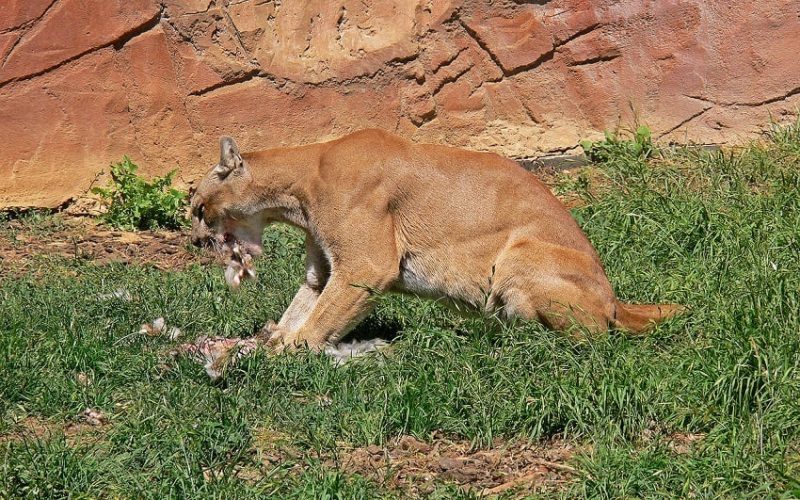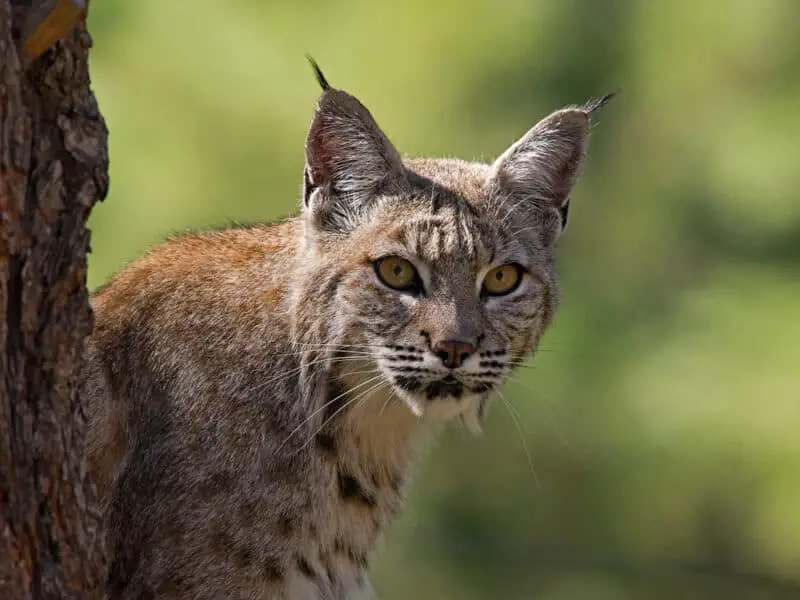The state of Oklahoma has two native species of wild cats. These are the bobcat and the mountain lion. Bobcats are abundant in Oklahoma. In fact, hunters and trappers harvest over 4500 of them in the state annually.
On the other hand, mountain lions were once common in Oklahoma. However, sometime after the 19th-century settlement by European Americans, they became extirpated from the state. While there are occasional sightings of mountain lions in Oklahoma, according to the Oklahoma Department of Wildlife Conservation, these animals are wanderers from other states.
People also report seeing black panthers in Oklahoma. However, state wildlife officials say there is absolutely no evidence supporting the existence of black panthers in the state.
We’ll talk more about all three of these feline predators further down in the article.

Bobcats in Oklahoma (Lynx rufus)
The American bobcat, which is also known as the red lynx, is a North American wild cat. Biologists believe that both the bobcat and the Canada lynx are descendants of the Eurasian lynx whose ancestors crossed into North America via the Bearing Sea land bridge.
Bobcats reside only in North America. Their range begins in Canada. Central British Columbia is the furthest north that bobcats live. Their range extends south through the United States and down into central Mexico. They are the most common wildcats in North America.
Bobcats are an elusive species of wild cat. They live in a variety of terrain. Look for them in broken habitat types that might include deciduous forests, dense forests, ravines, rocky ledges and/or outcroppings, and field borders.
The mottled black spots in the pattern of their fur give them excellent camouflage to live undetected in these environments.
Bobcats do not hibernate. They are active throughout the year. However, they’re rarely seen since they’re predominantly nocturnal or crepuscular animals. See
Bobcats are generally solitary animals. The exceptions to this generality are during mating season and when a female is raising young. They are territorial and have a home range that they patrol and post the boundaries of with claw-marked trees and scent markers of urine and feces.
In Oklahoma, male bobcat home ranges are 25 to 30 square miles. On the other hand, female bobcat home ranges average around 5 square miles.
What do bobcats look like?
A bobcat is much smaller than a mountain lion and slightly smaller than a Canadian lynx. An average bobcat is about twice the size of a house cat.
An adult bobcat is 2 to 3 feet long and weighs about 15 to 35 pounds. A female bobcat is quite a bit smaller than a male.
These animals have black-tipped tails that are short or “bobbed,” with dark bands on their upper surface. Their tail also has a black tip on its upper surface but not the back. They generally have reddish-brown coats that can also trend to gray, with mottled dark spots that range from black to dark brown on their sides. Additionally, they have dark stripes on their inner forelegs and a white underbelly.
From a side view, you will notice that a bobcat is slightly higher at the rump than at the shoulders. Bobcats and lynx have long hind legs in proportion to their forelegs.
Bobcats have black-tufted ears. In other words, they have tufts of hair that poke up above their ears and are black at the tips. They do have shorter ear tufts than their close relative, the Canadian lynx.
The backs of their ears, below the black tips, are black. In the center of the black of each ear, they have a single white spot. This gives the impression of a false eye on the back of each ear.
They also have a whiskered face that seems broader due to the ruff of fur on their cheeks and their whiskers. Their eyes are yellow with round black pupils.
Bobcats aren’t adapted for deep snow.
Compared to Canada lynx, which thrive in deep snow country, bobcats struggle more in the snow due to the fact that they cannot walk on top of it like lynx can. A lynx’s large paws function like snowshoes keeping it on the snow’s surface. On the other hand, compared to lynx, bobcats have small feet that tend to sink into the snow. If the snow is too deep and powdery, it reduces their mobility along with their ability to catch prey.
This is why the bobcat range dies out in southern Canada; from there on north, Canada lynx are more prevalent and bobcats less so.
Bobcats are also unable to live at higher elevations as lynx do in the winter. In the winter, lynx are able to stay in the high country to hunt their preferred prey, snowshoe hares.

What do bobcats eat?
Despite their comparatively small size, bobcats are aggressive, tough predators. At times, particularly during the winter, they prey on animals that are much larger than they are, such as white-tail deer. However, deer are not their go-to prey.
They feed on a variety of wild animals, but studies done in Iowa showed that 95 percent of a bobcat’s diet consists of small prey such as rabbits, mice, voles, and squirrels. They are opportunistic feeders and might also feed on such animals as beavers, muskrats, porcupines, birds such as wild turkeys, reptiles, insects, and carrion. When they take up residence close to farming or urban areas, their menu might occasionally also include small agricultural animals, house pets, and feral cats.
Interestingly, they even prey on venomous snakes even though they are not immune to the venom. They accomplish this by using their quickness to pin the snake’s head down with a paw, after which they dispatch the snake with a quick bite to its spine behind the head.
Oklahoma’s venomous snakes include the following:
- Prairie Rattlesnake (Crotalus viridis)
- Western Massasauga (Sistrurus catenatus)
- Broad-banded Copperhead (Agkistrodon contortrix)
- Western Cottonmouth (Agkistrodon piscivorus)
- Western Diamondback Rattlesnake (Crotalus atrox)
- Timber Rattlesnake (Crotalus horridus)
- Western Pygmy Rattlesnake (Sistrurus miliarius)
Reproduction and Life Cycle for Bobcats
In Oklahoma, Bobcats mate in late winter. During the breeding season, a male bobcat may mate with multiple females. If they successfully mate, the gestation period for bobcats is 60 days. Females mostly give birth in early spring.
After breeding, the male and female go their separate ways. The female takes all responsibility for the selection of a den site and the rearing of the young.
Look for maternal dens in a wooded area. Bobcats use features such as a rock outcropping, hollow trees or hollow logs, openings in the ground, the root masses of overturned stumps, or the space beneath a fallen tree as denning sites.
A bobcat litter consists of anywhere from 1 to 5 kittens. The average litter size, though, is around 3. Bobcat kittens are born with their eyes sealed, just like domestic cats are. However, their eyes will open when they are a week to 10 days old. By the time they are 2 months old, they will have replaced their spotted baby fur with a haircoat similar to what their parents have.
By mid-July, the kittens begin to venture out with the mother bobcats to fine-tune their survival skills. Their training may last into the early winter. By mid-winter, the kittens strike out on their own.
Recent research done in Indiana by the Indiana Department of Natural Resources indicates that bobcats sometimes disperse up to 100 miles from where they were born.
Female bobcats reach sexual maturity at 1 year of age, while males reach sexual maturity at age 2.
In Oklahoma, bobcats live 10 to 12 years in the wild.

Oklahoma mountain lion (Puma concolor)
Due to the fact that they live in a wide geographical area, mountain lions have a long list of regional names. In recent years, their scientific name was even changed from Felis concolor to Puma concolor. Some common names that mountain lions go by are cougar, panther painter, Andean Mountain lion, and puma.
Where are mountain lions typically found?
Mountain lions live on all three of the American continents. Their range begins in Canada’s Yukon territory and extends south through parts of North America, Central America, and South America to the southern tip of Argentina.
In Canada, the biggest populations of them are in British Columbia and Alberta. On the other hand, in the United States, they mainly live in the western states, the two midwestern states of South Dakota and Nebraska, and Florida in the southeast. In Florida, the cougar is called the Florida panther.
Although mountain lions are also native to most of the eastern and midwestern United States, they have been extirpated from most of this territory.
There was once a sizable mountain lion population in Oklahoma and on the Great Plains in general. However, the arrival of European settlers changed the dynamic.
Farmers on the newly settled lands couldn’t afford to have mountain lions preying on their livestock, so they eliminated them when they encountered them. What’s more, deer, which are a cougar’s primary food source, were almost completely eliminated from the landscape through unregulated hunting. These conditions caused the mountain lion to be extirpated from Oklahoma sometime in the 1800s.
Although there are occasional mountain lion sightings in Oklahoma, the Oklahoma Department of Wildlife Conservation attributes most of these to wandering cats from states with established populations, such as Texas, New Mexico, Colorado, Nebraska, and South Dakota. Also, Colorado, which is a contiguous state to Oklahoma with an established mountain lion population, has mountain lions in its southern portion whose home ranges cross over into the Oklahoma panhandle.
What do mountain lions look like?
To visualize what a mountain lion looks like, picture a giant house cat with short, light brown fur. Mountain lions are much larger than domestic cats, though. Average house cats weigh in at around 10 pounds, while male mountain lions can weigh over 200 pounds.
These large cats have muscular slender bodies, rounded small heads, and upright ears that are oval at the tip. Another characteristic that mountain lions have is their muscular long tails, which account for almost one-third of the entire length of the animal. They use their long tail for a counterbalance, moving it from side to side as they navigate through uneven terrain.
Mountain lions have a tan coat of short, coarse hair over most of their body. The area around their nose, the tip of their tail, and the tips of their ears are black. Their belly, the area above their upper lip, below their lower lip, and their chin are all white. They also have a sprinkling of dark hair on their backs. There are some coat color variances depending on geographical location.
Mountain lions are the second largest cats in the western hemisphere, smaller only than the Jaguar (Panthera onca). However, worldwide, the African Lion (Panthera leo) and the Tiger (Panthera tigris) are also larger.
Male and female mountain lions are phenotypically identical in every respect except for size. Males are 30 to 40% bigger than females. Though sizes vary considerably throughout the cat’s geographic range, an adult male typically weighs between 110 and 180 pounds, 50 to (82 kgs). A rare few of them grow bigger than 200 pounds (91kgs). Female mountain lions or queens average between 80 and 130 pounds (36 to 59 kgs). Adult males or toms will reach a length of 6 to 8 feet (1.8 to 2.4 M) from their snout to the tip of their tail. On the other hand, adult females are 5 to 7 feet long (1.5 to 2.1 M).

What do mountain lions eat?
Mountain lions are large predators that hunt alone from dark to morning, stalking their prey (mainly deer in the U.S. and Canada) from behind. On average, a lion kills a deer approximately once a week. Besides white-tailed deer, there is a population of mule deer in the Oklahoma panhandle. Additionally, they prey on most wild animals and domestic ones.
In Oklahoma, besides deer, this includes elk, feral horses, coyotes, raccoons, rats, feral hogs, javelina, porcupines, skunks, rabbits, various other small mammals, birds, reptiles, amphibians, livestock, pets, and just about any local native species they can catch.
A mountain lion may move its kill to a different location and cover it with dry leaves, grass, or pine needles to keep it safe from other animals. The big predator may return to the spot many days later to eat.
Large cats but not big cats
An interesting fact is that while an adult mountain lion might be a large cat or maybe even a big cat, they are not taxonomically classified as big cats because they cannot roar. A Snow leopard, for example, is smaller than a mountain lion. However, since snow leopards can roar and cannot purr, they are classified as big cats, while mountain lions are not. Another interesting thing that I can mention here is that mountain lions purr.
Since they purr and cannot roar, mountain lions are in the Felis genus, while big cats that cannot purr and can roar are in the Panthera genus.
Biologists taxonomically divided mountain lions into 2 sub-species in 2017. The first is (Puma concolor couguar) or northern cougar. Northern cougars range through North America, Central America, and possibly northwestern South America. The second sub-species is (Puma concolor concolor) or southern cougar. These cats range only in South America.
Are there black panthers in Oklahoma?
Every year, several people report that they have seen a large black feline somewhere in the wilds of Oklahoma. Some even venture to call these black panther sightings.
In this example from 2012, residents of Purcell, Oklahoma, reported seeing a large black cat prowling in the woods on the outskirts of town.
According to Oklahoma Wildlife Department officials, there are no black panthers living in Oklahoma’s wilds. Here’s a direct quote from their website.
“Though a popular myth, black panthers do not exist in the wild in North America. A black panther is a melanistic version of a large cat, usually an African leopard or a jaguar. These can sometimes be seen in zoos. Melanistic refers to the unusual black coloration produced by a hereditary, genetic mutation. There has never been a black mountain lion documented anywhere in their range.“
Leopards are native to Africa and Asia, so the only way that a black leopard could be present in the wilds of Oklahoma is if it were a released or escaped captive animal.
On the other hand, jaguars are native to all 3 American continents. In fact, there are documented cases of jaguars being present in Oklahoma’s neighboring states of Texas and New Mexico. See, I personally extrapolate from this information that while it’s unlikely that a black jaguar is or ever has been present in Oklahoma, it isn’t completely beyond the realm of possibility.
Recent Posts
The only venomous snakes in Washington State are Northern Pacific Rattlesnakes. The Northern Pacific Rattlesnake (Crotalus oreganus oreganus) is a sub-species of the Western Rattlesnake. Anyone...
Skunks are not classified as true hibernators. But they go into a state of torpor when the weather gets cold. Skunks are light sleep hibernators, along with opossums, bears, and raccoons. ...

